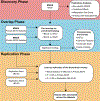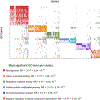Methylome-wide association findings for major depressive disorder overlap in blood and brain and replicate in independent brain samples
- PMID: 30242228
- PMCID: PMC6428621
- DOI: 10.1038/s41380-018-0247-6
Methylome-wide association findings for major depressive disorder overlap in blood and brain and replicate in independent brain samples
Abstract
We present the first large-scale methylome-wide association studies (MWAS) for major depressive disorder (MDD) to identify sites of potential importance for MDD etiology. Using a sequencing-based approach that provides near-complete coverage of all 28 million common CpGs in the human genome, we assay methylation in MDD cases and controls from both blood (N = 1132) and postmortem brain tissues (N = 61 samples from Brodmann Area 10, BA10). The MWAS for blood identified several loci with P ranging from 1.91 × 10-8 to 4.39 × 10-8 and a resampling approach showed that the cumulative association was significant (P = 4.03 × 10-10) with the signal coming from the top 25,000 MWAS markers. Furthermore, a permutation-based analysis showed significant overlap (P = 5.4 × 10-3) between the MWAS findings in blood and brain (BA10). This overlap was significantly enriched for a number of features including being in eQTLs in blood and the frontal cortex, CpG islands and shores, and exons. The overlapping sites were also enriched for active chromatin states in brain including genic enhancers and active transcription start sites. Furthermore, three loci located in GABBR2, RUFY3, and in an intergenic region on chromosome 2 replicated with the same direction of effect in the second brain tissue (BA25, N = 60) from the same individuals and in two independent brain collections (BA10, N = 81 and 64). GABBR2 inhibits neuronal activity through G protein-coupled second-messenger systems and RUFY3 is implicated in the establishment of neuronal polarity and axon elongation. In conclusion, we identified and replicated methylated loci associated with MDD that are involved in biological functions of likely importance to MDD etiology.
Conflict of interest statement
Conflict of Interest
B.W.J.H.P. has received research funding (non-related) from Jansen Research and Boehringer Ingelheim. Other authors declare no competing financial interests.
Figures



Similar articles
-
Convergence of evidence from a methylome-wide CpG-SNP association study and GWAS of major depressive disorder.Transl Psychiatry. 2018 Aug 22;8(1):162. doi: 10.1038/s41398-018-0205-8. Transl Psychiatry. 2018. PMID: 30135428 Free PMC article.
-
A Whole Methylome CpG-SNP Association Study of Psychosis in Blood and Brain Tissue.Schizophr Bull. 2016 Jul;42(4):1018-26. doi: 10.1093/schbul/sbv182. Epub 2015 Dec 9. Schizophr Bull. 2016. PMID: 26656881 Free PMC article.
-
Methylome-wide association study of anxiety disorders.Mol Psychiatry. 2023 Aug;28(8):3484-3492. doi: 10.1038/s41380-023-02205-w. Epub 2023 Aug 4. Mol Psychiatry. 2023. PMID: 37542162 Free PMC article.
-
A methylation study of long-term depression risk.Mol Psychiatry. 2020 Jun;25(6):1334-1343. doi: 10.1038/s41380-019-0516-z. Epub 2019 Sep 9. Mol Psychiatry. 2020. PMID: 31501512 Free PMC article.
-
Cell Type-Specific Methylome-wide Association Studies Implicate Neurotrophin and Innate Immune Signaling in Major Depressive Disorder.Biol Psychiatry. 2020 Mar 1;87(5):431-442. doi: 10.1016/j.biopsych.2019.10.014. Epub 2019 Nov 1. Biol Psychiatry. 2020. PMID: 31889537 Free PMC article.
Cited by
-
DNA Methylation as a Therapeutic and Diagnostic Target in Major Depressive Disorder.Front Behav Neurosci. 2022 Mar 30;16:759052. doi: 10.3389/fnbeh.2022.759052. eCollection 2022. Front Behav Neurosci. 2022. PMID: 35431832 Free PMC article. No abstract available.
-
Epigenome-wide DNA methylation in obsessive-compulsive disorder.Transl Psychiatry. 2022 Jun 1;12(1):221. doi: 10.1038/s41398-022-01996-w. Transl Psychiatry. 2022. PMID: 35650177 Free PMC article.
-
Brain aging in major depressive disorder: results from the ENIGMA major depressive disorder working group.Mol Psychiatry. 2021 Sep;26(9):5124-5139. doi: 10.1038/s41380-020-0754-0. Epub 2020 May 18. Mol Psychiatry. 2021. PMID: 32424236 Free PMC article.
-
No association between peripheral serotonin-gene-related DNA methylation and brain serotonin neurotransmission in the healthy and depressed state.Clin Epigenetics. 2024 May 27;16(1):71. doi: 10.1186/s13148-024-01678-y. Clin Epigenetics. 2024. PMID: 38802956 Free PMC article.
-
The missing hallmark of health: psychosocial adaptation.Cell Stress. 2024 Mar 12;8:21-50. doi: 10.15698/cst2024.03.294. eCollection 2024. Cell Stress. 2024. PMID: 38476764 Free PMC article.
References
-
- Judd LL. The clinical course of unipolar major depressive disorders. Archives of general psychiatry 1997; 54(11): 989–991. - PubMed
-
- Lopez AD, Mathers CD, Ezzati M, Jamison DT, Murray CJ. Global and regional burden of disease and risk factors, 2001: systematic analysis of population health data. Lancet 2006; 367(9524): 1747–1757. - PubMed
-
- Kessler RC, Berglund P, Demler O, Jin R, Koretz D, Merikangas KR et al. The epidemiology of major depressive disorder: results from the National Comorbidity Survey Replication (NCS-R). JAMA 2003; 289(23): 3095–3105. - PubMed
-
- Mueller TI, Leon AC, Keller MB, Solomon DA, Endicott J, Coryell W et al. Recurrence after recovery from major depressive disorder during 15 years of observational follow-up. The American journal of psychiatry 1999; 156(7): 1000–1006. - PubMed
Publication types
MeSH terms
Substances
Grants and funding
LinkOut - more resources
Full Text Sources
Other Literature Sources

